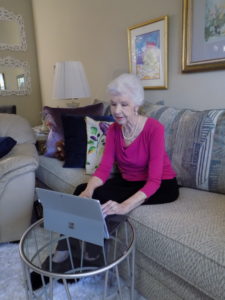The plan had been in the works for well over a year.
With the coronavirus quickly spreading across the country in early March, William L. Henrich, M.D., MACP, president of UT Health San Antonio, called an emergency meeting.
The virus was already killing people in Washington. But San Antonio hadn’t reported any deaths. Tough rules on individuals to stay home to prevent the virus from spreading had yet to be announced and schools and businesses remained open.
Still, he had an urgent request: We need to expand our telemedicine program and offer remote services to all our patients instead of bringing them in—and risking exposure to everyone.
It was March 6. “He asked if we could do this in a week,” recalled Mysti Schott, M.D., FACP, who was appointed interim chief medical informatics officer last spring to help guide UT Health San Antonio’s development of its electronic health record. She also led the strategy to help drive the university physician practice’s digital transformation.
Without hesitation, Dr. Schott and a team of technology experts responded: Yes.
“We already had all the building blocks in place and literally just needed to put in the last pieces of the puzzle, a policy and some operational decisions,” she said. “It was turning point. We knew we were ready and saw an opportunity on the wall.”
By March 16, she said, UT Health Physicians practices were offering video visits for its patients in the Verde Hills Primary Care Practice, and by March 20 video visits were available at all its locations, including the Medical Arts and Research Center and Mays Cancer Center, home to UT Health San Antonio MD Anderson Cancer Center. Three weeks later, more than 2,900 video visits had been conducted, she said.
“It’s been a tremendous effort. Our first visit in primary care was a patient who had symptoms that were concerning. Fever and respiratory symptoms,” Dr. Schott said. “We immediately saw the benefits and how virtual health can be used during a pandemic to keep patients who might have symptoms away from everybody who was healthy.”
Video visits are ideal for patients like Virginia Blakeney, 83, who already have an established doctor at UT Health Physicians. Patients need a MyChart® account to have a video visit appointment, but doctor’s offices help patients set up their accounts.
“The goal is to keep everybody as healthy as possible during this outbreak without the risk of exposure to infection and to avoid crowded waiting rooms,” Dr. Schott said.
 Complications after surgery and a stroke have kept Blakeney in and out of the hospital for five months, she said. She welcomed the idea of seeing a doctor from the comfort of her home.
Complications after surgery and a stroke have kept Blakeney in and out of the hospital for five months, she said. She welcomed the idea of seeing a doctor from the comfort of her home.
Blakeney was given the option to see her doctor via video visit on her cellphone. On Tuesday, she was able to use MyChart to securely communicate with her doctor. They met just as they would in the office. She maintains a positive attitude and does not worry about getting sick, she said.
“I’m not your usual person. Que sera sera,” she said. “I never get bored. I can sit in this apartment and I can take care of myself with small cooking and things like that.”
Despite her health complications and life in quarantine, Blakeney said she finished a novel she started years ago. And, while there were some glitches during her virtual visit, her concerns were addressed. Blakeney said she is looking forward to future calls with her doctor.
“I didn’t know this alternative existed,” she said. “It takes a lot of energy just to go see a doctor. This is marvelous. It takes away the burden of walking and parking.”
Like many others, she hopes life gets back to normal soon. She misses her friends the most—and her daily trips to McDonalds. A group of about 20 retirees have been meeting there daily for 20 years.
Seniors aren’t the only group benefiting from video visits. The new telehealth program is also available to children under 18, even for first-time patients. That’s an option that was not available prior to this state of emergency, Dr. Schott said.
“There are many rules that have been relaxed in this time frame,” Dr. Schott said. “We don’t know when all of this ends how all the rules are going to fall out.”
But she hopes doctors, hospital networks and clinics continue to rethink how the technology can be used in the future to promote remote visits.
“We plan to continue this program when this crisis is over. We’re hopeful that some of the emergency measures will also stay in place,” she said. “While it felt very slow moving this forward in the past year, this outbreak just made us speed it up. I’m very happy that we were ready for it.”


